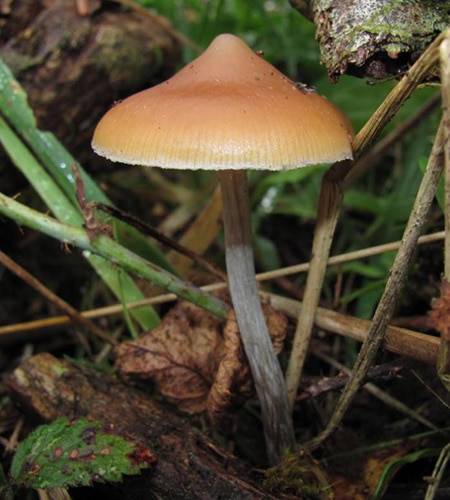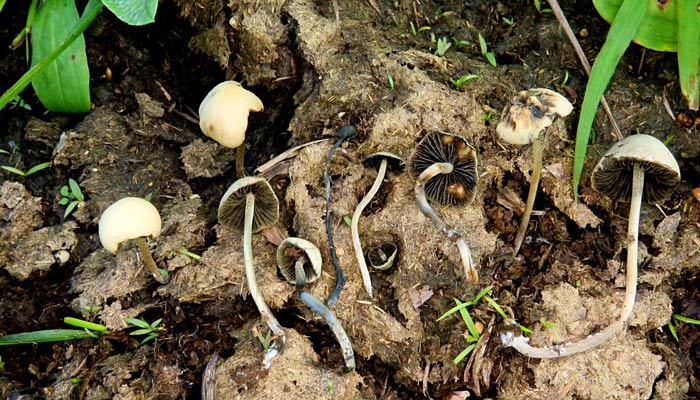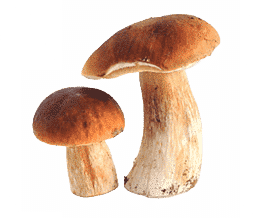Magic mushrooms are part of a class of psychedelics called entheogens, which can be translated to “manifesting divinity”.
Who doesn’t want to experience divinity?
But before you go reaching for divinity, it’s crucial that you invest the time to learn the characteristics of psilocybin mushrooms.
Here at Mindmend, we have your health in mind. We’ve put together everything you need to know about identifying mushrooms before embarking on your mushroom quest.
What are Psilocybin Mushrooms?
The most popular type of magic mushrooms is psilocybin mushrooms. They have psychoactive properties.
These mushrooms have long been considered sacred medicine. Aztecs, Mayas, and other ancient Mesoamerican cultures used magic mushrooms in religious and spiritual ceremonies. Some evidence suggests that they were used thousands of years before that by aboriginal Saharan tribes in North Africa.
Today, magic mushrooms are classified as a Schedule 1 drug in the US and many other countries.
However, a recent Johns Hopkins study seems promising. It shows that consuming magic mushrooms can have a beneficial effect, especially for people suffering from psychiatric disorders.
Johns Hopkins also proved in another study that using psilocybin mushrooms has long-lasting positive personality changes in consumers.
Identifying Magic Mushrooms
The variety of mushrooms out there is staggering.
The same goes for the psilocybin variety. As of now, there are 227 classified species which grow in:
- Mexico
- The USA and Canada
- Australia and the eastern islands
- Europe
- Asia
Certain species overlap in terms of where they grow, while some are endemic to specific areas because of their growing conditions.
Magic mushrooms come in many shapes, sizes, and colors. The best way to become an expert at identifying them is to know their appearance.
To start, get familiar with the most common types of psychedelic mushrooms. We’ve made a list of the top five that you are most likely to encounter.
Psilocybe Semilanceata

Psilocybe semilanceata is the most widely available shroom. They can be found in:
- Europe
- North and South America
- Australia
- New Zealand
- Asia
Another name for them is liberty caps because of their dark bell-shaped caps, with a pimple on top.
The caps range from 0.19 to 0.78 inches (0.5 to 2 cm) in diameter. As they age, their striations become more pronounced due to weather.
You will recognize them by their slim and wavy stems, which are 0.07 to 0.11 inches (2 to 3 mm) in diameter and 1.57 to 3.93 inches (4 to 10 cm) tall.
The stem color is cream, but it can become blue towards the base.
You can find these mushrooms in meadows and pastures, especially those where sheep graze.
This mushroom has a musty odor.
Be aware that, unlike psilocybe cubensis, psilocybe semilanceata do not grow directly out of dung.
Psilocybe Cyanescens

This psilocybin mushroom is also known as wavy caps. The waviness is their hallmark.
Caps are 0.59–2.36 inches (1.5–6 cm) in diameter and are rounder on top and closed around the stem.
Stems are 1.57–3.54 inches (4–9 cm) long x 0.09–0.3 inches (0.25–0.8 cm) wide. Their shape is cylindrical or slightly wider at the top than in the middle.
They smell like freshly cut green beans and flour.
These are one of the most powerful magic mushrooms, containing 1.96% active compound content by dry weight in North America.
This species can be found:
- West coast of the USA
- South of the Bay Area
- New Zealand
- Central and Western Europe
- Parts of Western Asia.
Psilocybe Azurescens

This psilocybe mushroom is also known as flying saucer mushroom.
This mushroom is among the top 5 most potent psychoactive psilocybin mushrooms. This is because it has a high concentration of psilocybin — up to 1.80%.
Not only that, but psilocybe azurences has an incredible amount of baeocystin. This is a chemical analog of psilocybin, which puts them among the most potent mushrooms in existence.
These mushrooms grow in the west coast of the USA, especially Oregon and Washington.
You will recognize them by a slim stem and a convex cap with a conical top.
The cap is 1.18 to 3.93 inches (3 to 10 cm) broad. It is caramel-colored when fresh, fading to a lighter straw color when dry.
Stem sizes can range from 3.54 to 7.87 inches (9 to 20 cm) long and 0.11 to 0.23 inches (3 to 6 mm) thick.
It is lightly curved and thickening towards the base, with a silky white color. It bruises to indigo-blue when touched.
Be prepared for the extremely bitter taste and flour-like odor.
Psilocybe Cubensis and Psilocybe Subcubensis

These two mushroom species are the most well-known types of mushrooms.
They can both be found growing in the same areas, including:
- Southeastern US
- Central America
- Northern South America
These magic mushroom species love tropical weather conditions. They are also found in:
- Thailand
- India
- Cambodia
- Vietnam
You can identify them by their unique shape. They are a stubby-stemmed parasol shape, with light to golden-brownish caps.
The caps are 0.59–3.14 inches (1.5–8 cm) broad. They are bulbous before fruiting and afterward, they become flat with a wide diameter.
This is the most popular kind of psilocybin-containing mushrooms, also called golden teacher, likely because of their yellowish color.
The stem is 1.57 to 5.9 inches (4 to 15 cm) long and 0.15 to 1.96 inches (0.4 to 5 cm) thick. Stem color ranges from white or yellowish, turning to yellow-brown as the mushroom ages.
The best time to look for these mushrooms is two months before the hottest period of the year. In the US, you can most commonly find them in May and June, although sometimes they can be found until January.
Panaeolus or Copelandia Cyanescens

Panaeolus cyanescens is also known as Hawaiian shroom.
Don’t let the name fool you; they grow all over the world:
- Southern North America
- Northern South America
- Central Africa
- Western Europe
- South and Southeast Asia
- Oceania
They are not among the most easily recognizable mushrooms, so take a careful look at their characteristics.
Their caps are 0.59 to 1.57 inches (1.5 to 4 cm) broad with a bell-shaped to convex shape.
The stem is 2.35 to 4.72 inches (6 to 12 cm) long and 0.07 to 1.57 inches (2 to 4 mm) thick. It bruises to a bluish color when handled.
This magic mushroom species is light brown when moist, and it fades to gray or white as it dries.
Your Supreme Mushroom Identifying Table
Here is a table with all the mushroom characteristics we talked about for your perusing convenience. Print it out, so you have all the characteristics with you when you go mushroom hunting.
| Psylocybe semilancelata | 0.19 to 0.78 in (0.5 to 2cm) |
Ellipsoidal, very dark purple-brown, smooth, 11.5-14.5 x 7-9 | Does not bruise | Olive-grey gills turn purple-black as the shroom mature | 0.07 to 0.11 in diameter and 1.57 to 3.93 in tall (2 to 3mm and 4 to 10cm) |
Hill slopes | Musty |
| Psilocybe Cyanescens | 0.59–2.36 in in diameter (1.5–6 cm) |
Ellipsoidal, very dark purple-brown, smooth, 9-12.5 x 5-7 | Pale blue | Purple-brown, with pale gill edges | 1.57 to 3.54 in long x 0.09 to 0.3 in wide (4 to 9 cm x 0.25 to 0.8 cm) |
Woodchip mulch | Freshly cut beans and flour |
| Psilocybe Azurescens | 1.18 to 3.93 in broad (3 to 10 cm) |
Ellipsoidal, purplish-brown to black 12-13.5 x 6.5-8 | Indigo blue | Yellowish-brown, often mottled with white near the edges | 3.54 to 7.87 in long and 0.11 to 0.23 in thick (9 to 20 cm and 3 to 6mm) |
Deciduous wood chips and dune grasses | Flour and bitter taste |
| Psilocybe Cubensis | 0.59–3.14 (3.93) in broad (1.5-8 (10) cm) |
Sub Ellipsoid, Dark purple-brown to blackish 11-17×7-12 |
Blue or blue-green | Gray, changing to dark purplish to blackish in age | 1.57 to 5.9 in long and 0.15 to 1.96 thick (4 to 15 cm and 0.4 to 1-5 cm) |
Dung of large herbivores | Flour |
| Panaeolus or Copelandia Cyanescens | 0.59 to 1.57 in (1.5 to 4 cm) |
Elliptical, black, 12-14 x 8-11 | Blue | Gray to black, with mottled faces | 2.35 to 4.72 in long and 0.07 to 1.57 in thick (6 to 12 cm and 2 to 4 mm thick) |
Dung in tropical and neotropical areas | Flour |
Get Picking
If you’ve come this far, we congratulate you! You are now basically an expert on identifying magic mushrooms. Get out there and put your knowledge to the test.
If you don’t feel like going out and doing the hard work yourself, we’ve got you covered. You can still get that potent mushroom effect. Just choose between our convenient magic mushrooms, capsules, or gummies.
Don’t forget to check out our blog for a wealth of information about shrooms or to get the answers to any and all questions you may have.
Featured Image: pixabay.com by TherapeuticShroom





